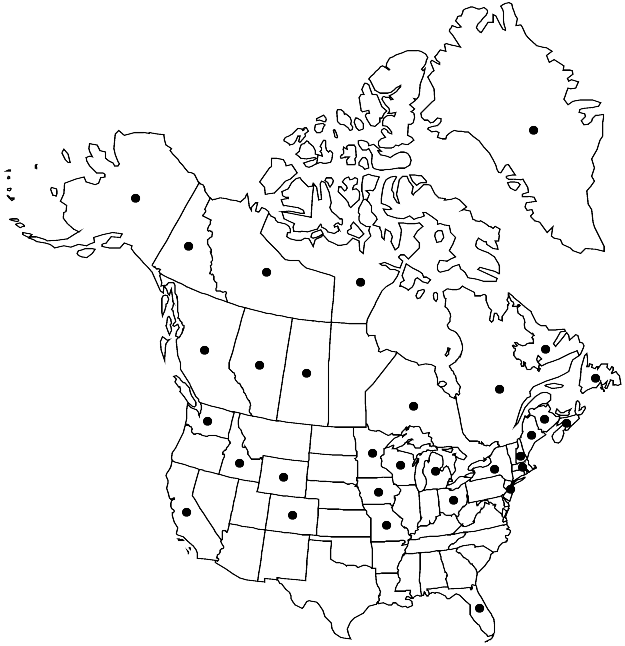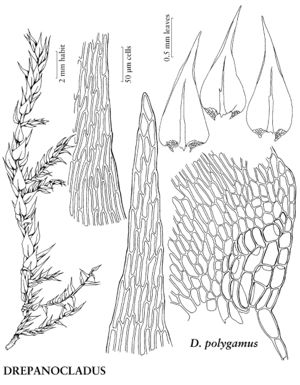Drepanocladus polygamus
Bryologist 100: 82. 1997.
Plants medium-sized to large. Stems irregularly and sparsely branched to ± pinnate. Stem leaves erectopatent to spreading, straight or falcate, ovate, broadly ovate, or rounded-triangular, gradually narrowed to apex, concave, (1.3–)1.7–3.5 × 0.6–1(–1.1) mm; base erectopatent to spreading, insertion slightly curved; margins entire or slightly sinuate; apex acuminate, acumen not or gradually differentiated, furrowed; costa single or 2-fid to 1/2–2/3 leaf length, or double and ending before mid leaf; alar region transversely triangular, reaching from margin 66–100% distance to costa; ratio of medial laminal cell length (µm) to leaf length (mm) 25.3–33.3. Sexual condition autoicous.
Habitat: Nutrient-rich wetlands, eutrophic fens, shores, ditches, submerged in pools and lakes, swampy forests
Elevation: low to high elevations
Distribution

Greenland, Alta., B.C., N.B., Nfld. and Labr., N.W.T., N.S., Nunavut, Ont., Que., Sask., Yukon, Alaska, Calif., Colo., Fla., Idaho, Iowa, Maine, Mass., Mich., Minn., Mo., N.H., N.J., N.Y., Ohio, Wash., Wis., Wyo., West Indies, Central America, South America, Eurasia (including Papua New Guinea), Africa, Pacific Islands (New Zealand), Australia, Antarctica.
Discussion
Some specimens of Drepanocladus polygamus are very similar to D. aduncus. However, D. polygamus is autoicous, whereas D. aduncus is dioicous, and in most cases at least parts of the shoots of D. polygamus are reminiscent of species of Campylium such as C. stellatum, with the leaves more or less spreading and acumen furrowed. In D. aduncus, the leaf acumen is more or less flat in straight-leafed specimens, which are the ones likely to be confused with D. polygamus, and the leaves are not spreading in a Campylium-like fashion.
The identity of Campylium polygamum var. longinerve (Renauld & Cardot) Grout (Hypnum polygamum var. longinerve Renauld & Cardot) is unclear, because no type material was available for study.
Selected References
None.
